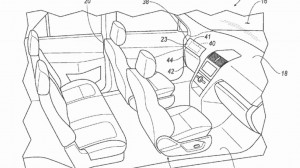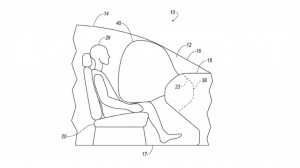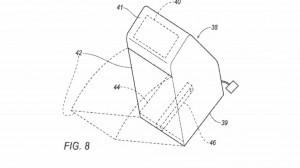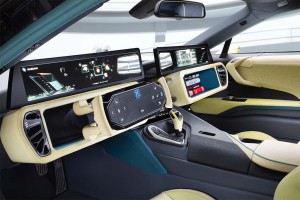Autonomous vehicles, we’re regularly told, are just around the corner, and fully driverless vehicles will soon follow. Ford, for one, has said it hopes to remove the driver from the picture entirely by 2021.
Now, a patent granted Ford this month reveals that the self-driving cars Ford is working on could give an owner the option to choose which mode it will operate in. Push a button and the steering wheel and pedals fold up and out of sight. Push again and they reappear, allowing manual driving.
That option may be essential, at least initially, as autonomous vehicle experts warn that coming up with a vehicle that can operate without a driver on all roads and under all conditions, may take years to develop, despite the optimistic prognostications of automakers like Ford, Daimler, Nissan and tech companies such as Google spin-off Waymo.
(Ford planning wave of new products, says new CEO. Click Here for the story.)
The first semi-autonomous vehicles are already on the road, and the level of technical sophistication is increasing rapidly. The latest version of the Mercedes-Benz S-Class, for example, allows not only brief, hands-off driving on limited-access roads, but a motorist can execute a pass simply by tapping the turn signals.
By the early part of the coming decade, so-called Level 3 systems should be available from a number of manufacturers. They’ll allow hands-free driving in a wide range of conditions, but an “operator” will have to remain behind the wheel, ready to take control in an emergency.
Not everyone believes that’s an effective solution, however. Having a driver sit behind the wheel, waiting to take over in an emergency is actually a dangerous solution, Ford’s global product chief Raj Nair told TheDetroitBureau.com last year, because, over time, “You lose driver awareness. You lose the ability for a human to respond in a timely manner.”
So, Ford is skipping what Nair called the “step-by-step incremental process,” and plans to go directly to truly driverless technology, what industry types refer to as Levels 4 and 5 autonomy.
The lower level would allow completely hands-free operation under a wide range of circumstances. But there may be so-called “geo-fencing,” where a human would need to take control, such as in areas of extreme traffic density or, perhaps, on poorly mapped roads. And the driver might also have to take over in bad weather, such as a white-out in a snowstorm.
Level 5 autonomy is the ultimate target and would mean that a human driver would never have to intervene – though there might be circumstances where they could take control if they wanted.
The Ford patent, first uncovered by Motor1 and issued to the automaker on August 10 of this year, would make it easy to convert from Level 4 or 5 autonomy to hands-on operation.
One of the advantages of high-level autonomy would be transforming the interior of a vehicle into a mobile lounge or office. A driver might swivel around, for example, to face back-seat occupants or to work at a built-in desk. So, in fully autonomous mode, Ford’s concept shows a way in which the steering wheel and pedals would completely retract beneath a cover with a “pleasing appearance,” according to the patent application. For manual operation that would return to their traditional positions.
The patent addresses the issue of what to do with the vehicle’s airbag. With the controls out, the driver’s bag would pop out of the center of the steering wheel, just as with today’s vehicles. In driverless mode, however, that bag would be disabled and a separate bag in the instrument panel would be deployed, much like on the front passenger’s side.
(FCA, BMW, Intel, Mobileye team up to jointly develop autonomous vehicles. Click Here for the full story.)
Ford’s original patent application, filed in February 2016, attempted to address a second problem, as well. “The lack of a steering wheel can handicap vehicle development by making it more difficult to place a vehicle under a driver’s control” to test how it would operate in “extreme dynamic maneuvers such as rapid lane changes.”
It appears that Ford’s solution would allow for both fully drive-by-wire electronic controls or permit a mechanical linkage between the steering wheel and the front wheels.
How Americans will accept the idea of fully driverless vehicles is uncertain. Surveys of the motoring public have yielded often conflicting responses. The ability to choose whether to relinquish or take control could broaden the appeal of future models.
Ford isn’t the only company thinking about ways to give drivers that choice, incidentally. Several recent concept vehicles, including the Rinspeed Etos and Nissan IDS also have introduced the concept of retractable controls. And since future vehicles are quite likely to go to fully drive-by-wire capabilities, some concepts have also introduced the idea that controls could be moved to either seat, so anyone up front could drive.
(Toyota, Intel team up for “big data” consortium. Click Here for more.)
Waymo, the Google spin-off has built some of its little bubble cars without controls, as well. That approach is likely to be used most extensively for ride-sharing services, like Uber and Lyft, where there would be no need for a driver.




